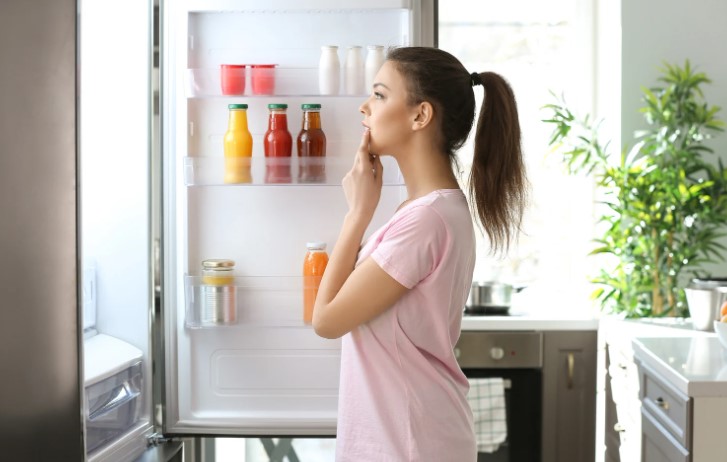- Understanding Fridge Temperature Settings - What Number Should My Fridge be on?
- What Number Should a Fridge Be On? - Decoding the Dial from 1 to 7
- What Is the Best Number to Set Your Fridge On?
- How to Properly Adjust Your Fridge Setting?
- Common Mistakes People Make with Fridge Settings
- Quick Comparison Table: Fridge Settings and Temperature Outcomes
- Conclusion: Setting Your Fridge Right for Food Safety and Freshness
Keeping my fridge at the right temperature isn’t just about keeping food cold — it’s essential for food safety, energy efficiency, and saving money.
But when faced with a dial ranging from 1 to 7, it can be confusing to know what number should my fridge be on. Let’s break it down properly.
Understanding Fridge Temperature Settings – What Number Should My Fridge be on?
Why Does the Fridge Temperature Matter?
The fridge temperature affects how long my food stays fresh and safe to eat.
If the fridge is too warm, bacteria can grow quickly, leading to food poisoning. If it’s too cold, some foods like lettuce and cucumbers might freeze in fridge and spoil.
The Food Standards Agency in the UK recommends keeping the fridge at 5°C or lower. Sticking to the right settings helps me ensure everything stays at a safe, optimal temperature.
What Temperature Should a Fridge Be in the UK?
In the UK, the ideal fridge temperature should be between 0°C and 5°C.
Anything above 5°C can put food at risk. I usually use a simple fridge thermometer to double-check the internal temperature if I’m unsure.
What Number Should a Fridge Be On? – Decoding the Dial from 1 to 7
When I first bought my fridge, I kept wondering what number should a fridge be on.
Many fridges in the UK use a dial numbered 1-7, where the higher the number, the colder the fridge.
It’s important to understand:
- 1 is the warmest setting.
- 7 is the coldest setting.
This simple logic helps me decide how to adjust my fridge depending on the season or how full it is.
Is 1 or 7 Colder on a Fridge?
On nearly every fridge, 7 is colder. Some newer models might show actual temperature readings, but if it’s a dial, higher usually means colder.
Which Number Is the Coldest on a 1-7 Fridge Dial?
Simply put:
7 = Maximum Coldness
1 = Least Cold
Whenever I need the fridge to be extra cold, like in summer or if I have a lot of meat stored, I turn it closer to 6 or 7.

What Is the Best Number to Set Your Fridge On?
What about Recommended Fridge Settings for Different Seasons?
Adjusting the fridge setting based on the season has helped me avoid food spoilage:
- Summer: I go for settings around 5 or 6.
- Winter: I usually set it to 3 or 4.
What are the Factors That May Affect Your Fridge Setting?
Other things that influence the fridge dial include:
- How packed the fridge is: A full fridge needs a stronger (colder) setting.
- Kitchen temperature: Hot kitchens mean I set the dial higher.
- Fridge model and age: Older fridges may not cool as efficiently.
How to Properly Adjust Your Fridge Setting?
What are the Step-by-Step Guide to Setting Your Fridge Temperature?
Here’s my simple method:
- Start with setting the dial at 4.
- Place a fridge thermometer on the middle shelf.
- Check after 24 hours — aim for 0°C to 5°C.
- Adjust the dial one notch higher or lower if necessary.
How to Check If Your Fridge Temperature Is Correct?
The easiest way is using a thermometer. I avoid checking near the door, as it’s warmer there. Consistent readings between 0°C and 5°C mean I’m good to go!

Common Mistakes People Make with Fridge Settings
Setting the Dial Too High or Too Low
I once thought setting it halfway would work year-round. In reality, I learned to tweak it based on the season and load.
Ignoring External Temperatures
A sunny, warm kitchen can warm up the fridge’s exterior. That’s why I adjust the setting in summer without fail.
Quick Comparison Table: Fridge Settings and Temperature Outcomes
| Dial Setting | Expected Temperature | Usage Advice |
| 1 | 7°C – 8°C | Too warm for safe food storage |
| 2 | 6°C – 7°C | Risk of bacteria growth |
| 3 | 5°C – 6°C | Acceptable for short periods |
| 4 | 4°C – 5°C | Ideal setting for daily use |
| 5 | 3°C – 4°C | Good for warmer days |
| 6 | 2°C – 3°C | Recommended during summer heat |
| 7 | 1°C – 2°C | Extremely cold — risk of freezing items |
Conclusion: Setting Your Fridge Right for Food Safety and Freshness
In the end, figuring out what number should my fridge be on isn’t hard once I know the basic rules.
I always aim for a fridge temperature between 0°C and 5°C and adjust according to the seasons and fridge load.
Remember:
Higher number = colder fridge
Lower number = warmer fridge
By setting my fridge correctly, I keep my food fresher, longer, and safer.
Related Article: How to Defrost Fridge Freezer Without Turning it Off?



0 Comments